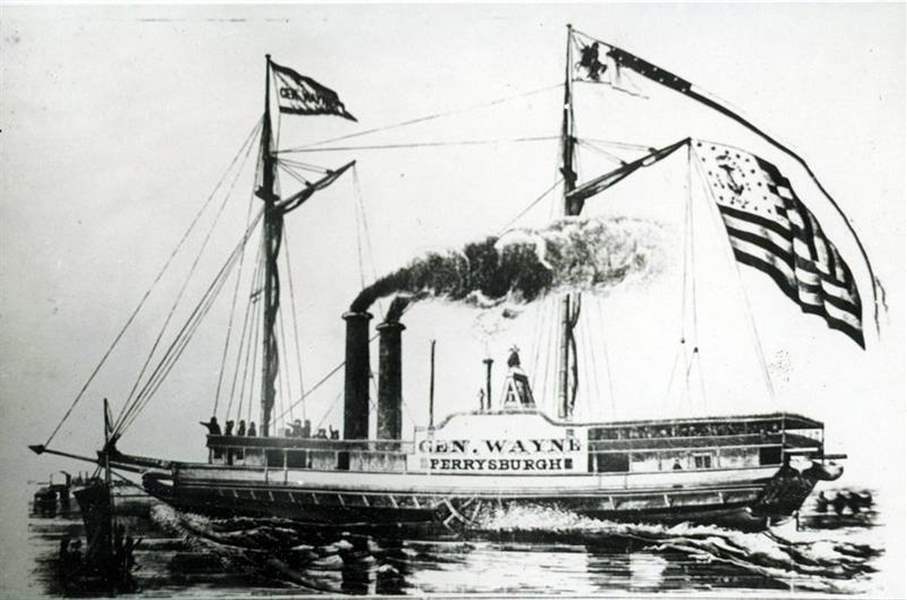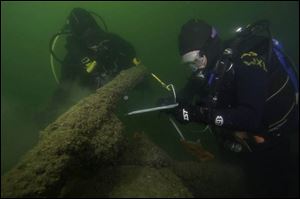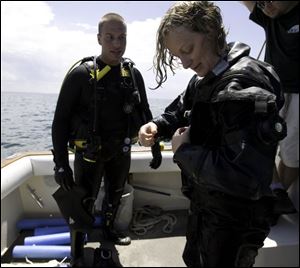
Lake Erie shipwreck turns lake into research lab
6/29/2008
The Great Lakes Historical Society has this rendering of the Gen. Anthony Wayne sidewheel steamboat.

The Great Lakes Historical Society has this rendering of the Gen. Anthony Wayne sidewheel steamboat.
VERMILION, Ohio - Loaded with passengers and a cargo of liquor and wine, the Anthony Wayne had not traveled far on its voyage from the docks of Toledo to a port in Buffalo, when an inexplicable explosion occurred - one that sent it to the depths of Lake Erie.
Now, more than 150 years later and two years after it was first discovered deep beneath the Lake Erie waves, underwater archaeologists are studying the sidewheel steamboat in its final resting place.
Believed to be the oldest steamboat shipwreck in the lake, the Anthony Wayne is broken up and buried in the lake's muck. It's cold down there - hovering at about 50 degrees - and the murky water makes visibility tough.
Despite the less-than-ideal research environment, archaeologists are working to preserve Great Lakes history by measuring and recording every detail of the vessel to re-create how it was built.
"This is part of the heritage of the lakes," said Texas A&M University graduate student Brad Krueger, who initiated the project. "You can learn a lot from these wrecks. They shouldn't be salvaged. By showing the actual value of underwater archaeology, it gives us a better understanding of our Great Lakes history."
With hopes of "bridging the gap in maritime history," Mr. Krueger said his project will result in the re-creation of "architectural elements that we just don't have."
What is known about the Anthony Wayne has been learned through newspaper articles and maritime records. There are no blueprints or photographs of the steamboat, only a lithograph created before the vessel was built in a Perrysburg shipyard in 1837.

Brad Krueger of Texas A&M University and Carrie Sowden, archaelogical director of the Great Lakes Historical Society, measure the port side bucket on the Anthony Wayne in Lake Erie.
The boat was 155 feet long and 27 feet wide. On each side, a 27-foot paddle wheel loomed, powered by steam generated in four onboard boilers.
It was the boilers on the ship's starboard side that exploded just after midnight on April 28, 1850, about six miles north of Vermilion, Ohio.
"We're doing an intense recording of the site," said Mr. Krueger, 25, who is originally from Ann Arbor. "We're trying to put it into a larger context of what this ship is."
Captain Tom Kowalczk, a retired auto worker and longtime diver, has spent much of his free time trolling Lake Erie. Moving at speeds hardly fast enough to produce a wake, he maneuvers his boat, the Dragonfly, up and down portions of the Lake Erie shoreline.
He searches for shipwrecks. And in 2006, as in years past, his patience paid off.

Using a sidescan sonar system attached to his boat, Mr. Kowalczk found what he believed to be the Anthony Wayne - a longtime goal on his list of ships to find.
The following year, a scuba dive beneath the waves to the ship confirmed it.
Mr. Kowalczk admitted that there was no name printed across the wooden remains of the vessel to make identification exact. But research of the area and of the ships that sank pointed to only one possibility, he said.
"It has paddle wheels, it has all the right dimensions, and it's in the right place," he said while his recreational boat floated above the site. "It's the only sidewheel steamboat out here. What else could it be?"
Only a few have viewed the remains of the Anthony Wayne.
Although its location has been made public, its exact location in Lake Erie is still not widely known. Those who have seen it readily admit its historical significance and acknowledge that it is not among the most visibly impressive of Lake Erie's shipwreck dives.

Brad Krueger and Carrie Sowden return from a dive.
The top portions of the paddle wheels are missing, yet their shapes are distinguishable. Gearing used to push the paddle wheels through the water is still visible, although hidden beneath a light layer of zebra mussels and other marine growth.
A short swim away is the recognizable shape of the bow, its pointed end rising up about four feet out of the Lake Erie muck.
"It was one of the notable shipwrecks in history because it was a passenger ship and a lot of people were killed," Mr. Kowalczk said. "There was lore attached."
Because passenger lists were kept on the vessels themselves, it is unknown how many people perished when the Anthony Wayne sank, Mr. Krueger said. What is known is that the steamboat sank very quickly.
"We know that in April, 1850, the vessel departed Toledo to Sandusky. Shortly after midnight, after leaving Sandusky, the starboard side boiler exploded inexplicably. It's unclear as to why it happened," Mr. Krueger said.
"There were survivors," he added. "From what I remember, there were about 33 people reported killed or missing, leaving about 50 or 60 people surviving."
The Anthony Wayne is just one of the thousands of shipwrecks scattered within the Great Lakes' graveyard. In Lake Erie, hundreds of ships have been found in ruins. Hundreds more have yet to be discovered.
Recording the history and current conditions of Lake Erie shipwrecks is among the goals taken on by the Great Lakes Historical Society, a nonprofit organization that operates the Vermilion-based Inland Seas Maritime Museum as well as the Peachman Lake Erie Shipwreck Research Center.
The group is dedicated to preserving Lake Erie maritime history, said Carrie Sowden, archaeological director for the historical society.
To further that goal, the Great Lakes Historical Society is sponsoring the Anthony Wayne project, she added.
"This is the biggest project that we've ever been a part of. It's a long-term in-depth study," Ms. Sowden said. "This is new for us but I hope not the only time we do it."
The Great Lakes Historical Society works to get out word on what shipwrecks Lake Erie has to offer, she added.
That's why the group participated in a project in August, 2006, to raise the bell on another of the lake's shipwrecks, the Cortland. The 173-foot wooden ship sank in 1863 after colliding with a steamer off Lorain, Ohio.
Its bell can now be seen among other Lake Erie artifacts in the maritime museum.
"We're trying to cover a lot of Ohio's Lake Erie coastline," Ms. Sowden said.
Contact Erica Blake at:
eblake@theblade.com
or 419-213-2134.